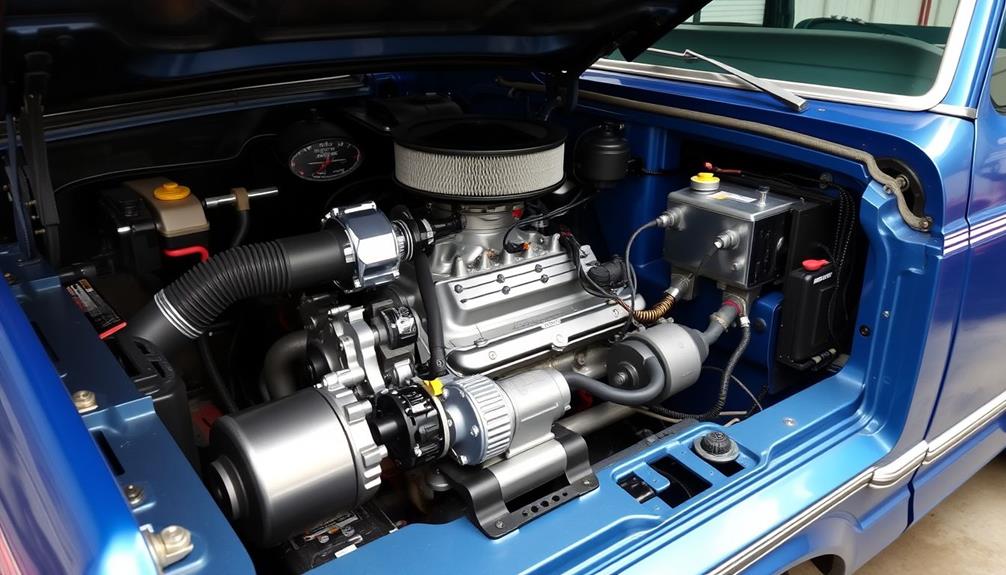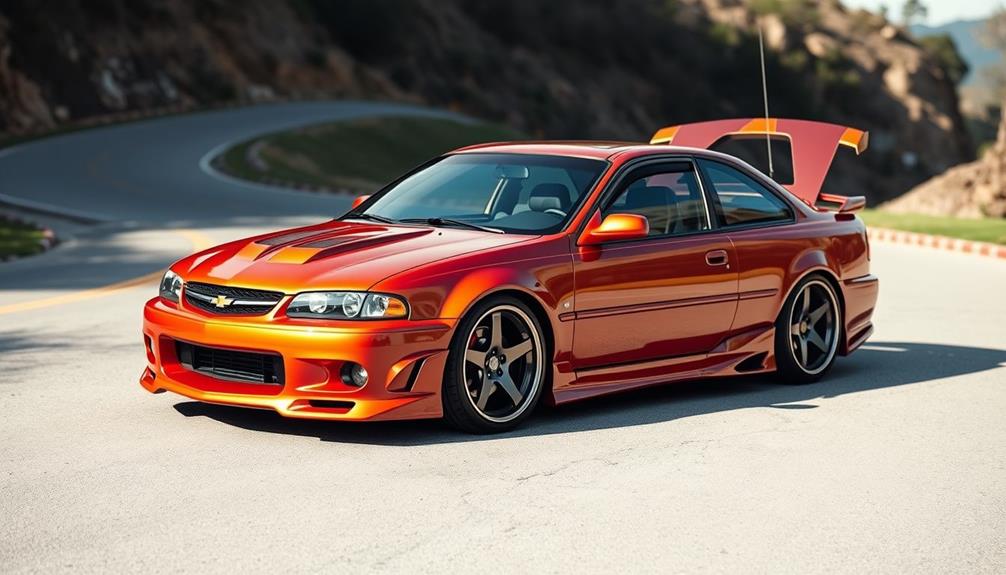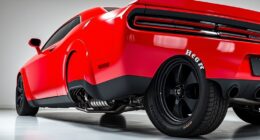Tuning your 1990 Ford F-150 can release significant power and improve its performance. Start with engine modifications like upgrading to GT40 heads and installing a Comp Cams camshaft for better airflow. Pair these with long tube headers and a high-flow exhaust system to maximize horsepower. Adjusting ignition timing and utilizing a flip chip tuner will enhance combustion efficiency. Budgeting around $1,000 for these upgrades is reasonable, offering great returns. Remember, regular maintenance and checks on enhancements are key to keeping your truck running smoothly. Keep exploring to discover even more tips and tricks for transforming your classic ride.
Key Takeaways
- Upgrade to GT40 heads and a Comp Cams camshaft for enhanced airflow and power in your 1990 F-150's Windsor engine.
- Utilize an SCT 6600 Flip Chip Tuner to reprogram your PCM for tailored performance and improved throttle response.
- Consider installing long tube headers and a custom exhaust system to reduce backpressure and increase horsepower.
- Regular maintenance and tuning checks are essential to ensure optimal performance of all upgraded components post-modification.
- Evaluate alternative engine options like the Mustang 302 HO for a more powerful and efficient swap compatible with your truck's drivetrain.
Engine Modifications
When it comes to enhancing the performance of your 1990 Ford F-150, engine modifications are essential. Upgrading to GT40 heads can greatly boost airflow, making a noticeable difference in your Windsor engine's performance.
Pairing those heads with a Comp Cams 31-255-5 camshaft optimizes engine performance by improving lift and duration, ultimately leading to better power output.
To further enhance your truck's performance, consider installing long tube headers. They're designed to improve exhaust flow, which can increase both horsepower and torque.
A custom single exhaust system with a pipe diameter of 2.25 to 2.5 inches, combined with a high-flow catalytic converter, reduces backpressure and enhances overall efficiency.
Don't forget about your air intake, either. Utilizing a K&N FIPK kit can provide minimal power increases while improving throttle response and air intake efficiency.
Each of these engine modifications plays a vital role in bringing out the best in your classic truck. By carefully selecting and implementing these upgrades, you can enjoy a noticeable improvement in your F-150's performance, making it more powerful and enjoyable to drive.
Performance Tuning Techniques

After making engine modifications to your 1990 Ford F-150, fine-tuning its performance becomes the next logical step.
To truly harness the power of your upgrades, you'll want to implement several performance tuning techniques that enhance throttle response and overall efficiency.
- Adjust Ignition Timing: Upgrading your ignition timing can greatly boost combustion efficiency, resulting in better throttle response and increased power output.
- Open Spark Plug Gap: By increasing the spark plug gap to .055 inches, you'll facilitate a better spark, leading to more efficient combustion and potential horsepower gains.
- Utilize a Flip Chip Tuner: Consider using a flip chip style tuner, like the SCT 6600. This allows you to reprogram the PCM, enhancing performance parameters tailored to your specific performance modifications.
Regular tuning and maintenance checks after these adjustments are essential for ensuring all upgraded components function efficiently.
Budgeting for Upgrades

Upgrading your 1990 Ford F-150 can be an exciting journey, but it's essential to set a realistic budget. A budget of around $1,000 is reasonable for basic upgrades, allowing you to include vital performance parts like a camshaft and headers.
Start by prioritizing modifications that give you the best return on investment. Upgrading the heads or exhaust system can lead to considerable performance gains without breaking the bank.
When budgeting for upgrades, remember that costs for performance parts can vary greatly. Take the time to shop around and find the best deals on components like shorty headers and fuel injectors.
Don't forget to factor in additional funds for labor and installation, especially if you're tackling more complex upgrades that require professional help.
Also, consider long-term savings on fuel efficiency against the initial upgrade costs. Better-performing components can improve your mileage over time, making your investment more worthwhile.
Alternative Engine Options

Evaluating the potential for performance upgrades, exploring alternative engine options for your 1990 Ford F-150 can elevate your truck to the next level.
By selecting the right engine, you can achieve a substantial performance boost while keeping costs manageable. Here are three great options to examine:
1. Mustang 302 HO Engine: This engine offers a remarkable balance of power and efficiency while maintaining compatibility with your existing drivetrain.
It's a reliable choice that won't require extensive modifications.
2. 460 Engine: If you're after serious power, the 460 can deliver an impressive power-to-cost ratio.
Its increased displacement and torque capabilities make it a fantastic option for those wanting to enhance their truck's performance considerably.
3. 5.0L and 5.8L Windsor Engines: These engines are also viable alternative engine options, providing a nice mix of power and efficiency.
They're relatively easy to find and swap into your F-150, ensuring a smoother shift.
Before making any decisions, evaluate your truck's current value against the costs of the new engine and necessary modifications.
Proper drivetrain compatibility is essential for a successful swap.
Community Insights

When diving into the world of tuning your 1990 Ford F-150, you'll quickly discover that the community surrounding these classic trucks is a treasure trove of knowledge and experience.
Enthusiasts often favor traditional upgrades like carburetors, headers, and ignition systems over modern tuning technologies. You'll find plenty of forums where fellow owners share their successes with specific modifications, offering valuable insights into which performance parts yield the best results.
Members frequently emphasize the importance of selecting compatible performance parts to guarantee a seamless fit with your truck's existing drivetrain and engine components.
Since options for aftermarket tuners are limited for older models, many turn to mechanical enhancements instead of electronic adjustments. This hands-on approach has cultivated a supportive network where you can ask questions and share troubleshooting tips.
Transmission Enhancements

Enhancing the transmission of your 1990 Ford F-150 can dramatically boost its overall performance and driving experience.
By focusing on key transmission enhancements, you can take your classic truck to new heights. Here are three effective upgrades to evaluate:
- Install a Shift Kit: A shift kit improves shifting performance by providing firmer shifts and reducing lag. This makes your driving experience sportier and more responsive, giving you better control.
- Upgrade the Rear Axle Gear Ratio: Switching to a higher axle gear ratio, like 3.55, enhances torque handling and complements larger tires. This upgrade will improve acceleration, making your F-150 feel more powerful on the road.
- Use a Performance Torque Converter: Upgrading to a performance torque converter allows for better power transfer and efficiency. This enhancement works best when paired with other modifications for maximum impact.
Don't forget to maintain your transmission fluid and filter regularly.
Common Misconceptions

Despite the wealth of information available, many misconceptions linger about tuning the 1990 Ford F-150. For instance, you might think that installing aftermarket air intakes, like the K&N FIPK kit, will give you considerable power gains. However, in real-world conditions, the stock air intake often performs just as well, if not better.
Another common myth is that throttle body spacers greatly boost horsepower. In reality, they usually provide minimal improvements that may not justify the expense.
You might also believe that simply adding a performance chip will drastically enhance your truck's power. While these chips can help, tuning adjustments tend to yield better results when combined with physical engine modifications.
Additionally, many assume that dual exhaust systems are always superior to single ones. In some configurations, a well-designed single exhaust can outperform dual setups due to reduced back pressure.
Finally, it's important to remember that not all modifications are legal. Be sure to check local emissions regulations, as some upgrades mightn't comply for street use.
Maintenance After Upgrades

After addressing common misconceptions about tuning your 1990 Ford F-150, it's time to focus on what comes next: maintaining your truck post-upgrade. Proper maintenance is essential to guarantee the performance gains you've achieved remain intact and your truck runs smoothly.
Here are three key maintenance tips to keep in mind:
- Regular Checks: Inspect upgraded components like spark plugs and fuel injectors. Regular checks help prevent issues and guarantee peak performance.
- Monitor Performance: Use diagnostic tools to monitor your engine's performance. This can help identify any irregularities or potential problems that may arise after modifications.
- Scheduled Maintenance: Don't skip fluid changes and inspections of the ignition and fuel systems. This routine maintenance will maintain the efficiency of your new performance parts.
Additionally, keep detailed records of all upgrades and maintenance performed. This not only assists in troubleshooting future issues but can also enhance your truck's resale value.
Historical Context

When you look at the 1990 Ford F-150, you see how truck design evolved during the late '80s and early '90s, focusing on aerodynamics and fuel efficiency.
This era set new performance standards, pushing manufacturers to enhance capabilities while meeting consumer demands.
The F-150's key engine specifications, like the 4.9L inline-six and 5.0L V8, reflect this shift towards more powerful and versatile options.
Evolution of Truck Design
The 1990 Ford F-150 stands as a significant milestone in the evolution of truck design, showcasing a shift towards more aerodynamic shapes that improved fuel efficiency and handling.
This eighth-generation model moved away from the boxy styles of its predecessors, offering a modern look that appealed to a wider audience. You'll notice a remarkable emphasis on driver comfort, with enhanced seating and a more user-friendly dashboard layout.
Here are three key features that define this evolution:
- Aerodynamic Design: The sleek shapes reduced drag, contributing to better fuel economy.
- Engine Options: With choices like the 4.9L inline-six and a 5.0L V8, the F-150 catered to diverse power needs while maintaining efficiency.
- Fuel Injection: This technology replaced older carbureted systems, allowing for improved performance and fuel management.
The introduction of diesel engine options further expanded its appeal, meeting the demands of both utility and recreational users.
With a gross vehicle weight rating of 6,250 lbs, the 1990 F-150 balanced power and practicality, marking a new era in truck design.
Performance Standards of Era
During the late 1980s and early 1990s, performance standards for light-duty trucks like the Ford F-150 began to shift, reflecting a growing demand for power without sacrificing efficiency.
The 1990 F-150 showcased this change with a range of engine options, including a 4.9L inline-six producing 150 horsepower and a 5.0L V8 generating 185 horsepower. These figures highlighted the era's focus on balancing power and fuel economy, catering to drivers who needed robust performance for both work and play.
The gross vehicle weight rating of approximately 6,250 lbs was typical for light-duty trucks at that time, impacting their handling and overall performance. With the choice of a three-speed automatic or five-speed manual transmission, you could influence both power delivery and efficiency based on your driving preferences.
Moreover, the F-150's body-on-frame construction and simple, reliable drivetrain emphasized durability, appealing to users who valued longevity in their vehicles.
Compared to today's trucks, which often exceed 400 horsepower, the 1990 F-150's performance standards nicely encapsulate the evolution of power and technology in the automotive industry.
Key Engine Specifications
In 1990, the Ford F-150 offered a robust 5.0L V8 engine that generated about 185 horsepower and 270 lb-ft of torque, showcasing the power typical for trucks of that era. This engine's design includes a cast iron block and aluminum cylinder heads, which enhance durability and ease of maintenance—qualities that many truck owners appreciate even today.
When considering the key engine specifications, here are three notable features:
- Gross Vehicle Weight Rating (GVWR): Around 6,250 lbs, making it capable of handling various hauling and towing tasks.
- Transmission Options: Available with either a 4-speed automatic or a 5-speed manual transmission, offering flexibility in driving styles and performance.
- Fuel Economy: Typically ranges from 12 to 15 miles per gallon, depending on driving conditions and load.
This combination of engine specifications and design elements has made the 1990 Ford F-150 a classic choice for those wanting a reliable, powerful truck.
Tuning Options and Equipment

When tuning your 1990 Ford F-150, choosing the right equipment is key to maximizing performance.
You'll want to explore various tuning techniques, including the use of flip chip tuners, while being aware of common myths that can mislead you.
Let's break down the recommended tools and methods to get the most out of your truck.
Recommended Tuning Equipment
For tuning your 1990 Ford F-150, investing in a flip chip style tuner, like the SCT 6600, is vital for optimizing your truck's performance.
This tuner can reprogram the vehicle's PCM, enhancing power delivery and overall efficiency. Since older models require specific tuning equipment, you'll want to focus on options tailored to your F-150's unique needs.
Here are three recommended tuning equipment items to take into account:
- SCT 6600 Flip Chip Tuner: This device will allow you to adjust the engine parameters for improved performance.
- Upgraded Intake System: A high-flow air intake can complement the tuner, helping your engine breathe better and increase horsepower.
- High-Performance Exhaust System: Replacing the stock exhaust with a performance system reduces back pressure, further enhancing your truck's performance.
While tuning may only provide minimal gains on a stock vehicle, combining these performance modifications will yield more significant improvements.
After tuning, be sure to monitor engine performance using diagnostics to ascertain everything runs smoothly and effectively.
Tuning Techniques Overview
Tuning techniques for your 1990 Ford F-150 focus on enhancing engine performance through a combination of digital adjustments and physical upgrades. One effective method is using a flip chip style tuner like the SCT 6600, which allows you to tweak engine performance parameters.
Keep in mind that tuning for OBI one systems differs from newer models, so make certain you have compatible equipment.
While tuning alone often yields minimal gains on stock vehicles, incorporating performance modifications like upgraded intake and exhaust systems is essential for significant improvements. If you've built your engine, you'll notice even greater benefits from tuning adjustments.
The combination of engine upgrades and tuning techniques creates a powerful synergy that maximizes your truck's potential.
It's worth noting that the availability of aftermarket tuners for older models can be limited, which is why many enthusiasts prefer traditional performance modifications.
Engaging with community forums can provide valuable insights into what works best for your specific setup. By exploring these tuning options and equipment, you can release the full potential of your classic F-150, guaranteeing it performs at its best for years to come.
Common Tuning Myths
Many myths surround the tuning of older vehicles like the 1990 Ford F-150, leading enthusiasts to misunderstand what can realistically be achieved through tuning alone.
While you might think tuning will give your truck a massive horsepower boost, the truth is that significant performance gains often come from strategic modifications first, such as upgrading the intake and exhaust systems.
Here are three common tuning myths to be aware of:
- Tuning alone boosts horsepower: It's important to enhance existing components, like the throttle body and fuel delivery system, for better results.
- Aftermarket chips are always effective: Many enthusiasts overestimate the power of aftermarket chips. In many cases, simple timing adjustments can deliver similar performance improvements without the extra cost.
- All tuning options are the same: Tuning for OBI models like the 1990 F-150 requires specialized knowledge and equipment, as the stock PCM doesn't support the same options as newer vehicles.
Frequently Asked Questions
How Much Horsepower Does a 1990 Ford F150 Have?
The 1990 Ford F-150 has a few engine options. The standard 4.9L inline-six produces 150 horsepower, while the 5.0L V8 offers 185 horsepower, and the 5.8L V8 provides 210 horsepower, depending on your choice.
How Can I Get More Power Out of My F-150?
Imagine your F-150's engine roaring like a lion. To release that power, consider upgrading your intake, installing headers, and optimizing ignition timing. These tweaks will transform your ride, giving you the thrill you crave.
What Is the Value of a 1990 F-150?
The value of a 1990 F-150 ranges from $5,000 to $15,000, depending on its condition, mileage, and any modifications. Classic models with original parts typically fetch higher prices among collectors and enthusiasts.
How Many MPG Does a 1990 Ford F150 Get?
When you're cruising in a 1990 Ford F-150, expect around 12 to 16 MPG in the city and 15 to 20 on the highway, depending on how you drive and maintain your truck.
Conclusion
Tuning your 1990 Ford F-150 can transform it from a classic truck into a powerhouse that rivals today's modern rides. By making thoughtful engine upgrades and embracing performance tuning techniques, you'll breathe new life into your vehicle. Just remember, it's not all about horsepower; it's about creating a balanced ride. So, don't treat your classic like a flip phone—give it the tech it deserves and enjoy the thrill of a truly personalized driving experience!










